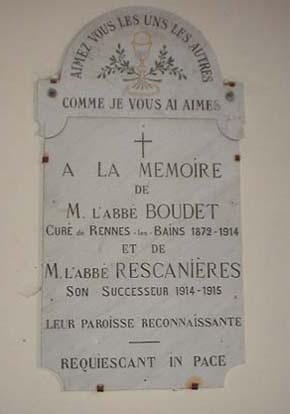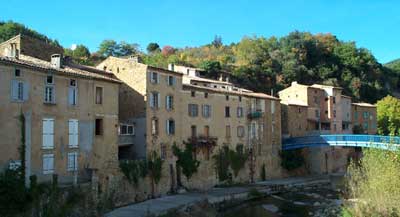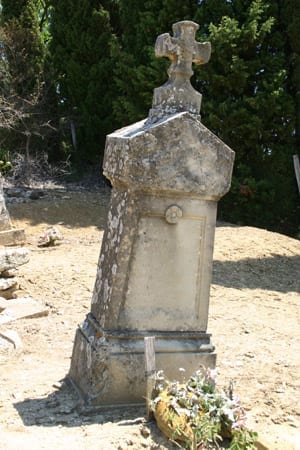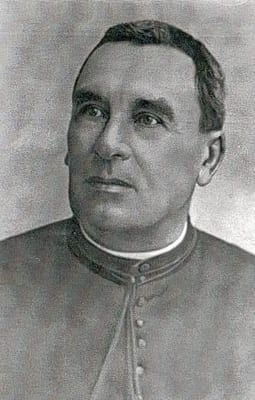Rescanières: another unsolved death?

A memorial slab
Stand in the covered hallway that is in front of the church of Rennes-les-Bains, and you will find that the community indeed had respect – more so than for the other priests that served the community, it seemed – for Boudet. That in itself should be remarkable. However, there is also another name on the memorial slab: Rescanières.
The interesting thing is that Rescanières only served as priest of Rennes-les-Bains for one year: 1914 to 1915. It left him little time to leave an impression, it seems, but apparently he did. And the reason why and how he did so, has to do with his sudden, unexpected – and premature death: Rescanières was only 47 years old when he died. Might it therefore come as a surprise that some believe that he was murdered?
A priestly life
Joseph Rescanières – sometimes, erroneously, written as “Rescanière”, though the saying goes that in French, there is no incorrect name to write a proper name – was born in 1878 and succeeded Boudet as priest of Rennes-les-Bains. They were big shoes to fill, as Boudet had served his town for a long time. And it was Boudet who had been made part of the mystery of Rennes-le-Château<. Some even saw him as the true mastermind. But Gérard de Sède, the man who propelled the mystery to the forefront, believed that Rescanieres too was part of the mystery – and was poisoned. And we note that researcher Jean-Luc Robin believes that Boudet was murdered too – equally poisoned, based on the manner in which his body decomposed.
An obituary on Rescanières appeared in the “Semaine religieuse de Carcassonne” on February 13, 1915, which provides some further information on the priest. It begins, of course, by stating that his death was unexpected, as he was still very young.
The obituary states that he wanted to be a priest from the moment he got to know the Eucharist. When he entered seminary, he achieved first prices on a regular basis. Once priest, he was named vicar of Montréal. This in itself is quite interesting, as Montréal is the site of another Asmodeus-like statue – once stationed in Rennes-les-Bains he must have found it coincidental – if not more – that the priest of his neighbouring parish, Saunière, possessed a somewhat similar one.
Climbing the ladder to God
Montréal proved a challenge to the young priest, who felt he was not equipped to handle the tasks that came with this rather large – and important – parish. When you look at the size of the church, it indeed demands respect. In Rescanières, it instilled fear.
No doubt, the diocese felt that – with his distinctions as a student – he would be able to climb the ladder of the Church’s hierarchy, and hence he was entered onto that ladder on a higher level than somewhat normal – take for example the small if not miniscule parishes where Saunière was dropped once he had qualified as a priest.
But noting his reluctance, Rescanières was reassigned as vicar of Ginestas, roughly in between Lézignan-Corbières and Narbonne.
Apparently with less stress on his shoulders, he began to develop his oratory skills, which landed him a posting in the parish of St Paul in Narbonne, working as a vicar to Canon Mario. Here, he was able to perfect his skills of preaching and approaching his audience even more.
After eight years of missionary, he asked the bishop for some rest, and it seems that Rennes-les-Bains would be that location. Perhaps the need for rest betrayed an underlying health problem, but if so, it seems he alone was aware of it.
As Boudet had vacated his position, Rescanières found that the community was more than together and he seems to have been able to cement it even further. If he was ill, he did not show it, as he was known for his energy and enthusiasm to lead community life in the most joyous of circumstances. And, as these were war times, the town also had no less than sixty-odd soldiers who were convalescing in the hospitals of the town from their injuries, but even though they were passers-by, they nevertheless seemed to be integrated in the town’s everyday life.
Disaster
 On Monday, February 1, 1915, the faithful of Rennes were preparing for mass. Rescanières had not yet arrived, even though he was normally more than punctual. Someone decided they should go and tap on the door of his room, no doubt suspecting something was wrong, but perhaps merely thinking the priest was ill. When they did, there was no reply. When they entered, they found the priest dead on the parquet floor. He was dressed, his face pale from death. It was clear that he had not died in bed, trying to climb out, collapsing on the floor. He was wearing his cassock and was apparently preparing or in the process of carrying out a private religious ceremony. It seems that something had struck him in the middle of his daily activities – a stroke or a heart attack, no doubt.
On Monday, February 1, 1915, the faithful of Rennes were preparing for mass. Rescanières had not yet arrived, even though he was normally more than punctual. Someone decided they should go and tap on the door of his room, no doubt suspecting something was wrong, but perhaps merely thinking the priest was ill. When they did, there was no reply. When they entered, they found the priest dead on the parquet floor. He was dressed, his face pale from death. It was clear that he had not died in bed, trying to climb out, collapsing on the floor. He was wearing his cassock and was apparently preparing or in the process of carrying out a private religious ceremony. It seems that something had struck him in the middle of his daily activities – a stroke or a heart attack, no doubt.
On Wednesday, February 3, Doyen, the priest of Couiza, assisted by his colleagues of Espéraza, Arques, la Serpent, Serres, Castelreng and Bugarach, performed his funeral service; soldiers carried the coffin, while the choir sung a Requiem. Interestingly, Rescanières was not buried in Rennes-les-Bains, but taken to Notre-Dame de Marceille, as it was here that he wanted to be buried. Notre-Dame de Marceille, of course, had been so cherished by his predecessor Boudet, and we can only wonder why he shared that enthusiasm – which is a bit odd. However known the pilgrimage site was, it is not blatantly obvious why he would be buried there.
Questions
 Image: Gélis's tombstone in Coustaussa
Image: Gélis's tombstone in Coustaussa
Gérard de Sède felt – speculated – that Rescanières was poisoned. Sceptics might argue it is unfounded speculation, merely to create intrigue and sell books. And it is indeed true that there is no evidence that he was murdered – purely because no autopsy was performed and people do die suddenly. The same applies to Boudet, who was furthermore of a certain age.
But… we all know about Miss Marple, the amateur detective that appears in twelve of Agatha Christie's crime novels. She was later made the subject of a television series. Observers noted that Miss Marple lived in the village of St. Mary Mead, a small village, and that it surely had to be the crime capital of the world, as hardly a week went by without Miss Marple having to solve a murder in her village.
Well, the region of Rennes-le-Château might have been seen as the early 20th century equivalent of St Mary Mead. It, of course, started with a genuine assassination: Gélis. Roughly fifteen years later, Boudet and Rescanières died shortly after each other. Less than two years later, Saunière dies. Coincidence? Or evidence of a serial killer, or rather, a series of assassinations, to “get rid” of certain priests “who knew too much”? A cleaning exercise…
A framework
 Jean-Luc Robin believed that Saunière was on the payroll of the Habsburgs, and there is indeed evidence that this aristocratic family had some connection to our enigmatic priest. Furthermore, there were apparently rumours in Couiza – circulating especially at the start of the First World War – that the priest of neighbouring Rennes-le-Château was a German spy! And it is a matter of record that within the period of the First World War (1914-1918), we have three priests dying: Saunière and Boudet – both identified as the central figures of this enigma, as well as Rescanières, Boudet’s successor.
Jean-Luc Robin believed that Saunière was on the payroll of the Habsburgs, and there is indeed evidence that this aristocratic family had some connection to our enigmatic priest. Furthermore, there were apparently rumours in Couiza – circulating especially at the start of the First World War – that the priest of neighbouring Rennes-le-Château was a German spy! And it is a matter of record that within the period of the First World War (1914-1918), we have three priests dying: Saunière and Boudet – both identified as the central figures of this enigma, as well as Rescanières, Boudet’s successor.
More importantly, as Robin and several others have pointed out, Saunière lived in fear – in fear of his life, a fear that began after Gélis’ death, and continued during his “haunting” by the bishop, who wanted – demanded – to know where Saunière’s money came from. He felt as if someone was out to get him, and it wasn’t just the bishop. Even earlier, with the construction of his domain, it was clear that he designed it as a modern version of a secured fort.
Hence, when he sees the death of Boudet and Rescanières, even if they were natural deaths, it is not at all unlikely to suggest that a tormented soul becomes paranoid and wonders whether they too are out to get him. And that he will want to make sure that he does not end up like them. Let us note that researcher Graeme Simmans believed that Saunière was murdered too – poisoned, though again, there is no evidence for this, again because no medical examinations ever occurred. Why would they?
Room for a model?
By 1915, Saunière is indeed not in the best of health. Even if totally normal, the death of Rescanières has underlined to Saunière that even healthy, relatively young men die. And it is soon afterwards that a new phase – the final phase – in his life begins: he orders the model, as he seems to want to give certain knowledge to a designated heir – or heirs. And it seems that he is once again looking towards a major cash injection, as he is preparing for major works to be carried out on his estate and the village in general. But, alas, less than two years after Rescanières’ death, Saunière too is suddenly struck down. Coincidentally, his death occurred in the month before Western powers truly began to make decisive victories against the Germans – and we can only wonder whether the people of Couiza – and perhaps others who had seen Saunière as a German spy – felt that justice had been served.
Intriguingly, in the lead-up to the Second World War, Saunière’s maid, Marie Dénarnaud, was said to have been visited by SS officer Otto Rahn, now known to be a close confident of Heinrich Himmler, the second man in Germany, after Adolph Hitler.
Oh, and then, of course, there are the two never explained dead bodies that were found buried in the gardens of the Villa Bethania.
Filip Coppens<
In memory of Jean-Luc Robin
- Login o registrati per inviare commenti
Similar By Terms
|
(English)
|
(English)
|
(English)
|
(English)
|
|
(English)
|
(English)
|
(English)
|
(English)
|









Commenti recenti
13 anni 41 settimane fa
13 anni 42 settimane fa
13 anni 42 settimane fa
13 anni 42 settimane fa
13 anni 45 settimane fa
13 anni 51 settimane fa